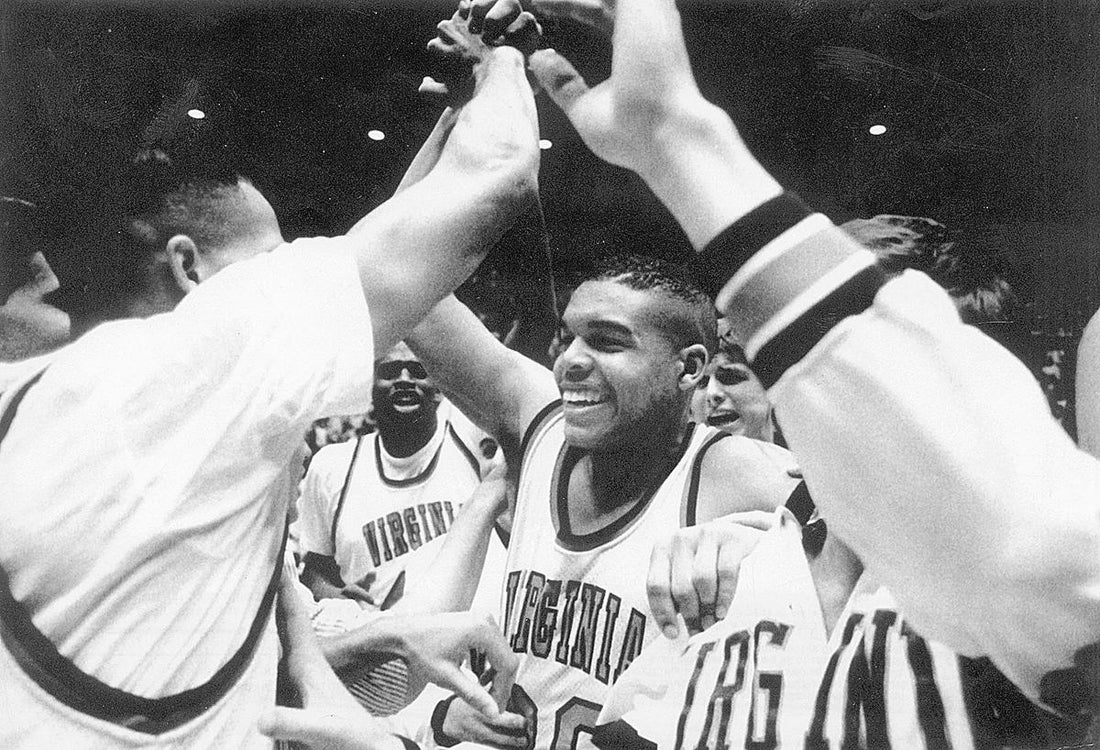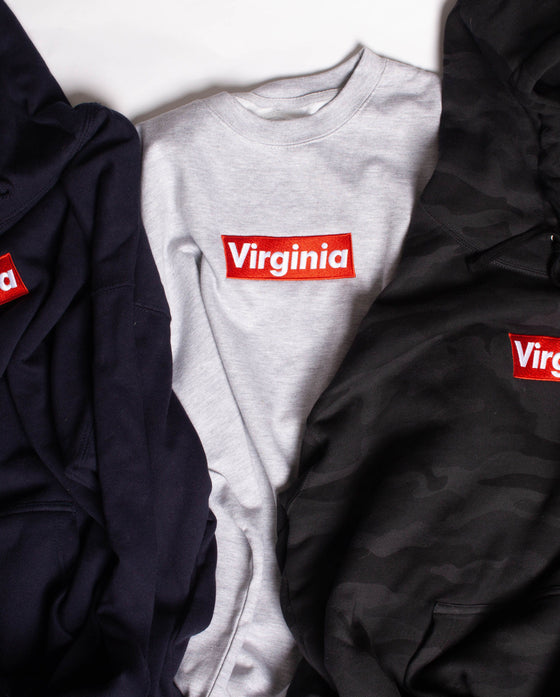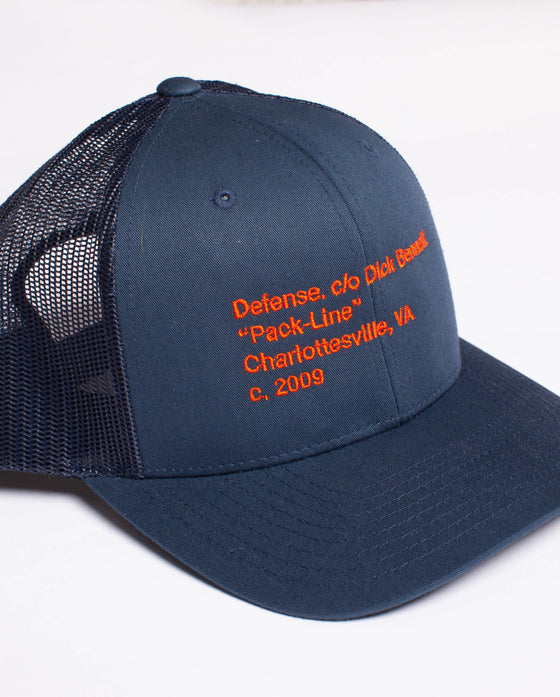Bryant Stith - A Figure Bigger Than the Game

A timeout is called, the whistle blows, and Bryant Stith walks up to trainer Ethan Saliba on the sideline. The Virginia - Providence 1989 NCAA tournament fist round contest is turning out to be a dogfight. "Ethan," Stith says, "I'm going to hand you these, and you better not tell Coach Jones, Coach Holland, or Coach Odom."
"What is it?" Saliba responds.
"It's my tooth," says Stith, "it came out."
"Is it bothering you?" questions Saliba.
"Man, it's killing me," Stith notes, "but you better not say anything."
So, for the remainder of the game, his shattered front tooth remained his and Saliba's secret. Still, Stith was forced to swallow the blood gushing from the top of his mouth to prevent anybody from noticing his chipped tooth and exposed nerve. When the final horn sounded, the 'Hoos reigned victorious by a score of 100-97, and the first year Stith finished with nineteen points on seven-for-nine shooting along with seven rebounds.
That performance from Stith is just one in a long list of legendary moments that established him as the closest thing the Virginia men's basketball program has to a Jordan or Kobe-like figure.
Listen to Bryant Stith on the Locker Room Access Podcast
Recruiting Process
Born and raised in Emporia, Virginia, Stith catapulted onto the national stage with his play in a number of notable camps leading up to his sophomore year of high school. With that recognition came significant interest from top-tier college programs.
Duke, Virginia, Georgia Tech, and Villanova made Stith's final list heading into his senior year of high school. Stith actually took visits to each of those schools with eventual Duke star Christian Laetner, and the two of them were eyeing the prospect of playing together in college. "It made sense," Stith says in retrospect, "we though we could be a heck of a one two punch."
While Stith recognized that intriguing prospect, eventually, he had to go with the school that showed him the most interest. "Back then," he recalls "
As such, Stith says that, while he loved everything about Duke, he felt "the love at the University of Virginia and
Arrival at Virginia
So, in the summer of 1988, Stith arrived in Charlottesville hoping to make an immediate impact. That he did, as in his first season wearing a Virginia uniform, he averaged 15.5 PPG to go with 6.5 rebounds in roughly twenty-nine minutes of play per contest.
While his regular season play rivaled the first year production of Ralph Sampson, where Stith exploded was in the postseason. Along with his gutsy performance in that first round Providence game, Stith scored twenty-six points in the Round of 32 against Middle Tennessee, and a seaon high twenty-eight against number one seed Oklahoma in the Sweet Sixteen.
At the time, that Oklahoma game was the biggest of Stith's career and he rose to the challenge. "Nobody gave us a snowball's chance in hell to win that game," says Stith. Nonetheless, on the backs on Stith and Richard Morgan, the Wahoos advanced to the Elite Eight.
Unfortunately, the eventual National Champion Michigan shot lights out against the 'Hoos, and severely limited Stith. "Michigan came out and played a junk defense on me," Stith recalls, "and that was the first time that I had ever had a team play a diamond and one against me. It really confused me, and I struggled to score in the first half."
With Stith struggling against the junk defense, and veterans Richard Morgan and John Crotty on an off night, the Wahoos failed to keep up with the high-flying Michigan Wolverines, dropping the game 102-65.
"They were just too talented and too good," Stith remembers, "but I grew up a lot. I remember going back and watching the replays of that game... because if anybody played me
Second Year Jump
With the '89 team's leading scorer, Richard Morgan, graduating, expectations were high for the 1989 ACC Rookie of the Year heading into his second season. As anticipated, Stith came out firing. With a bump in playing time (28.5 MPG his first year to 35.2 MPG as a second-year) came an increase in scoring production as well, as he scored 20.8 PPG (up from 15.5 the year before). In fact, his performance in the regular season earned Stith a First-Team All-ACC Selection.
Once again, Stith led the team to the NCAA tournament where the seventh seed Wahoos met Notre Dame in the first round. "The crowd was rocking," Stith says "It was a very good game, it was a close game. We were able to be victorious." That they were, as Crotty (28 points) and Stith (21 points) led the 'Hoos to a 75-67 victory over the Fighting Irish.
But what sticks with Stith the most from that season is the happenings of the next game against Syracuse. "I may have had one of the best games I had in my career" he recalls, "I was hitting everything. I was hitting threes, I was hitting mid-range jump shots, and I was getting on the offensive glass."
Stith was hitting just about everything that game, finishing with thirty points on 11-21 shooting from the field, and 5-7 from three point range. While Stith was on fire, the rest of the team struggled to score leaving the door open for the Orange.
"It came down to the last shot," Stith remembers "I had beten my guy, and Derrick Coleman had rotated over and forced me to take a pull-up jumpshot from the short corner." He pauses, before admitting "Man, I wasn't good enough... I didn't have that fade-away jumpshot in my repertoire."
Unfortunately, Stith's shot was blocked by Coleman as the final buzzer sounded. "I relive that shot over and over again," says Stith, "If I had shot a fade-away jump-shot I think I would've been able to get the ball over his outstretched arms, and it would've been a bucket... If he hadn't blocked that shot it was going in."
With that loss, Stith was halfway through his college career, but with an experienced team returning for the 1990-1991 season, the program had high hopes that the team would once again make a deep run in postseason play.
Holland Resigns
But with the end of the 1990 season also came the conclusion of Terry Holland's fifteen year stint as the head coach of the program "I found out at the last minute," Stith says, noting that "they called a team metting and they said that Coach Holland was not coming back. He explained why. I understood." Stith goes on to explain that "it had nothing to do with the team," adding "it had everything to do about respect and what he had built since he had been at the University of Virginia, and he felt disrespected because they were moving other projects ahead of UVa basketball, and UVa basketball put our athletic program on the map."
Stith was understandably upset at the time, but he emphasizes that "When
At that point, Stith went to the Athletic Director to make it clear what it would take for him stay. "I had several conversations with Athletic Director Copeland," Stith explains "and I shared my heart, I shared my feelings, and I shared who I wanted to be the next coach."
"I went into his office, and I was very open," Stith adds "I was very honest, I was very transparent, and I think he felt my passion. Whether that persuaded him to hire Coach Jones, I don't know... I knew the impact Coach Jones had," Stith says "and I just presented that all to Athletic Director Copeland,"
Whatever impact Stith had on Copeland's decision, the thirty year old associate coach Jeff Jones became the head coach of the Virginia men's basketball team.
Disappointing Final Years Despite Individual Success
Throughout his final two years in a Virginia uniform, Stith continued to impress. From his astonishing nineteen straight points in the final six minutes of play against Notre Dame in 1991, to three consecutive All ACC First Team selections, an NIT MVP award, and becoming the all-time leading scorer in UVa basketball history, Stith solidified himself in Virginia basketball lore.
But despite all of Stith's individual accomplishments, the team failed to reach the same heights of success. In Stith's third year, the team lost in the first round of the NCAA tournament, while in his fourth and final season, they failed to make the NCAA tournament altogether.
His third year, an injury to glue guy Anthony Oliver and an unfortunate schedule forced the eleventh ranked 'Hoos to play three straight games in Tobacco road. They lost all three of those games on the road, first to #6 Duke, then to #9 UNC, and then to Wake Forest.
Nonetheless, Stith set high expectations for his final year in Charlottesville. "I had so many expectations for my final year," he says "I wanted to be able to make it to the NCAA tournament and see if we could at least get back to the Elite Eight... I just had so many aspirations."
"But it took us a while to gel," he explains "and we kind of hit our stride toward the end of the season. Even though we were not able to make the NCAA Tournament, we were able to win the NIT," adding "that was a sweet ending to a very good career for me."
The Next Level
From there, Stith shifted his focus to success at the next level. Picked thirteenth in the 1992 NBA Draft, Stith headed West to play for the Denver Nuggets. Early in his career, Stith took on a leadership role. In fact, in only his second year, the Nuggets named him team captain. "I worked so hard in practice," he says, adding "there was nobody in the Denver Nuggets program that outworked me, and when they came to me with the idea I was like 'you want me to lead this locker room of men?' and they said 'Bryant, you already lead with your performance in practice and on the court.'"
"As I became more mature," he adds, "I embraced that leadership role, I became more vocal, and I became the voice of the locker room." According to Stith, a significant aspect of that role came in the weight room. "The NBA wasn't set up like it was today," he says "there was no strength coach. There was no conditioning program."
"I basically took
That dedication manifested itself in a long and successful career in the NBA. Playing ten seasons and 586 games in the NBA, Stith averaged 10.1 PPG for his career. He spent his first eight years in Denver and started for the vast majority of his time in the Mile High City.
After a down year in the 1998-1999 season, Denver traded Stith to Boston. "It was great," Stith says of playing in Boston, "I understood the history of the game... just having the opportunity to go there. I thought it was pretty cool." In Boston, Stith carved out a starting role, and in seventy-four games, averaged 9.7 points per contest.
After one season in Titletown, Stith headed to Cleveland. But once the 2002 season was over, Stith realized that for the sake of his family, it was time to step away from the game. At the time, a number of sons of high profile athletes had been mixed up in bad situations, with some even being found dead. "My wife and I were having conversations," Stith recalls, "and we were like 'the most important thing to us is our kids' and we didn't want to see them go down that road."
Retirement
For the sake of his kids, and despite being offered a number of significant jobs in the NBA (including broadcasting, coaching, and front office positions), Stith moved his family back to his hometown. "If I had just dove into my professional journey right after i had retired, my kids would've been thrust into that pool of being at risk." He adds that "we decided to move back to Lawrenceville and provide a stable upbringing for Brandon, B.J., Bri, and Brook. So they can grow up around family... and get them a solid foundation.
Looking back, Stith says that "I think we made the right choice," adding that "I had made a lot of money. How much is enough? We just felt the price of my family was more important than having an All American job."
With that decision made, Stith turned his attention to raising his kids, and when the time came, coaching his sons.


